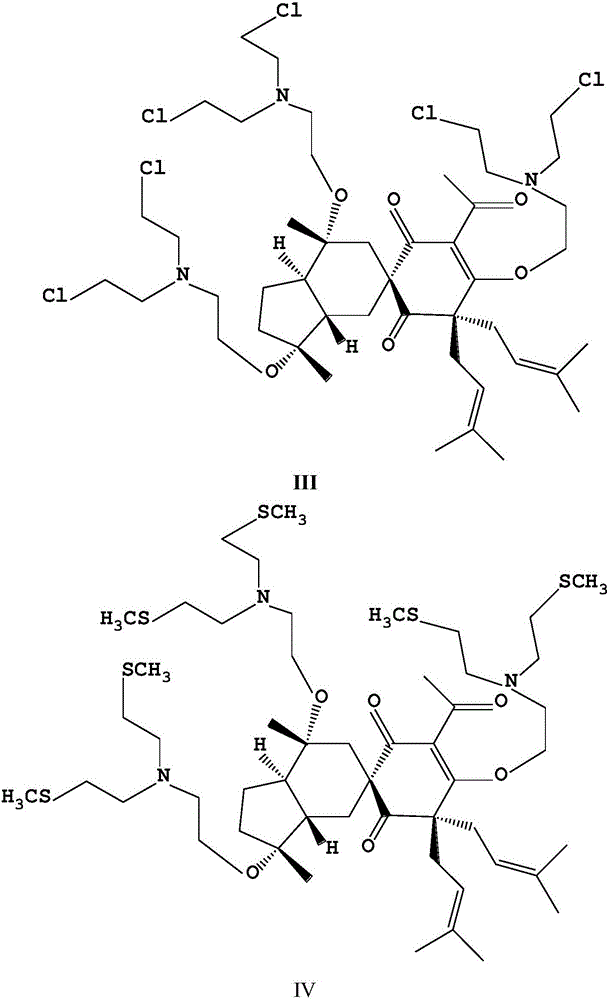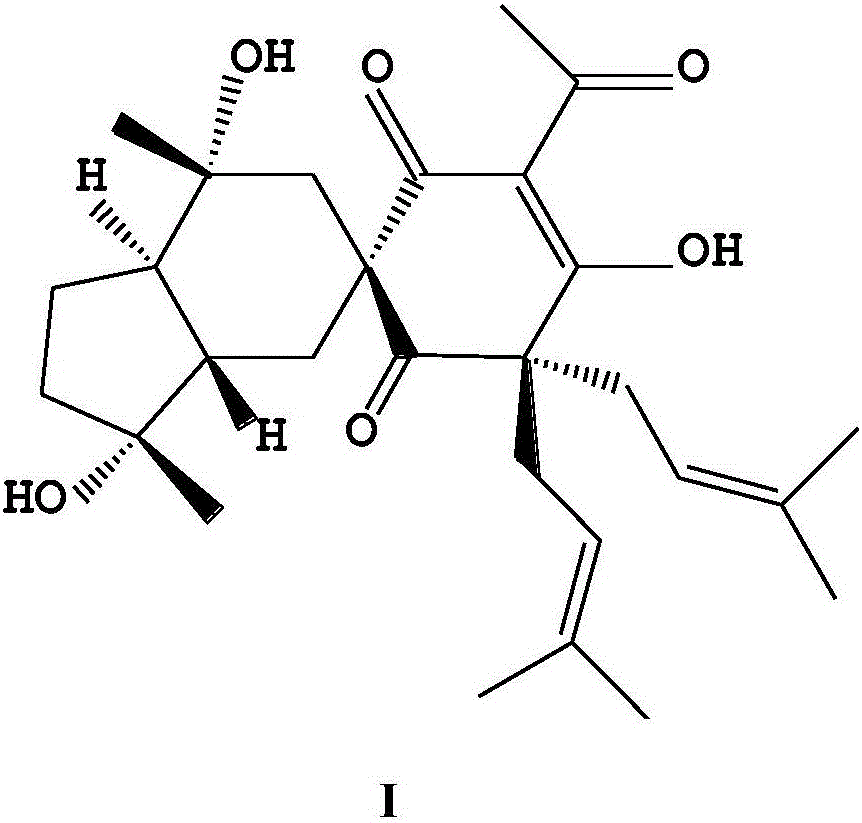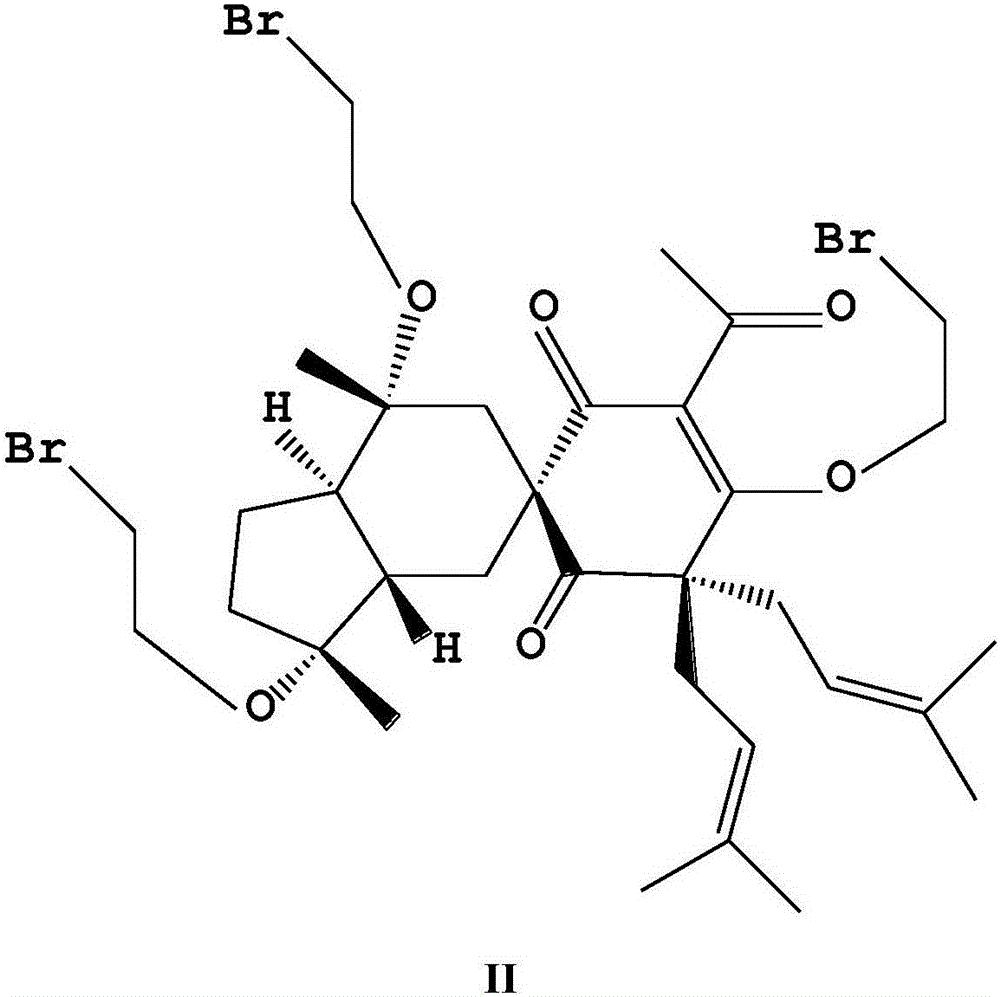Application of derivative composition of Harrisotone A to anti-inflammation
A composition and compound technology, which can be used in drug combinations, anti-inflammatory agents, medical preparations containing active ingredients, etc., and can solve the problems of high toxicity and low safety.
- Summary
- Abstract
- Description
- Claims
- Application Information
AI Technical Summary
Problems solved by technology
Method used
Image
Examples
Embodiment 1
[0014] The preparation of embodiment 1 compound Harrisotone A
[0015] The preparation method of compound Harrisotone A (I) refers to the literature published by Sheng Yin et al. (Sheng Yin et al., 2009.Harrisotones A–E, five novel prenylated polyketides with a rarespirocyclic skeleton from Harrisonia perforata.Tetrahedron 65(2009) 1147–1152 )Methods.
[0016]
Embodiment 2
[0017] The synthesis of the O-bromoethyl derivative (II) of embodiment 2 Harrisotone A
[0018] Compound I (472 mg, 1.00 mmol) was dissolved in 15 mL of benzene, and tetrabutylammonium bromide (TBAB) (0.08 g), 1,2-dibromoethane (3.760 g, 20.00 mmol) and 6 mL of 50% sodium hydroxide solution. The mixture was stirred at 35 °C for 3 h. After 3h, the reaction solution was poured into ice water, extracted twice with dichloromethane immediately, and the organic phase solutions were combined. Then the organic phase solution was washed twice with water and saturated brine successively, then dried with anhydrous sodium sulfate, and finally concentrated under reduced pressure to remove the solvent to obtain a crude product. The crude product was purified by silica gel column chromatography (mobile phase: petroleum ether / acetone=100:1.5, v / v), the brown concentrated elution band was collected and the solvent was evaporated to obtain a yellow powder of compound II (602mg, 76%) .
[00...
Embodiment 3
[0023] The synthesis of the O-(dichloroethylamino) ethyl derivative (III) of embodiment 3 Harrisotone A
[0024] 1. Synthesis of O-(dihydroxyethylamino)ethyl derivatives of Harrisotone A
[0025] Compound II (396 mg, 0.5 mmol) was dissolved in 22 mL of acetonitrile, anhydrous potassium carbonate (690 mg, 5.0 mmol), potassium iodide (252 mg, 1.5 mmol) and diethanolamine (1051 mg, 10 mmol) were added thereto, and the mixture was heated to reflux for 3 h. After the reaction, the reaction solution was poured into 25 mL of ice water, extracted three times with an equal amount of dichloromethane, and the organic phases were combined. The combined organic phases were successively washed with water and saturated brine, dried over anhydrous sodium sulfate, and concentrated under reduced pressure to remove the solvent to obtain a crude product. The crude product was purified by silica gel column chromatography (mobile phase: petroleum ether / acetone=100:0.5, v / v), and the light brown co...
PUM
 Login to View More
Login to View More Abstract
Description
Claims
Application Information
 Login to View More
Login to View More - R&D
- Intellectual Property
- Life Sciences
- Materials
- Tech Scout
- Unparalleled Data Quality
- Higher Quality Content
- 60% Fewer Hallucinations
Browse by: Latest US Patents, China's latest patents, Technical Efficacy Thesaurus, Application Domain, Technology Topic, Popular Technical Reports.
© 2025 PatSnap. All rights reserved.Legal|Privacy policy|Modern Slavery Act Transparency Statement|Sitemap|About US| Contact US: help@patsnap.com



